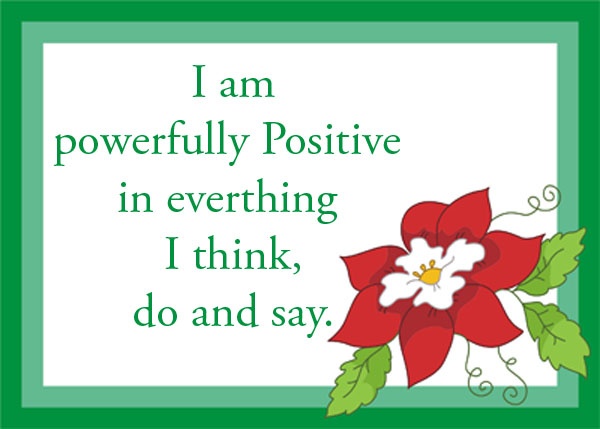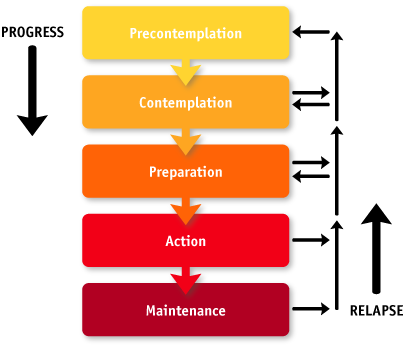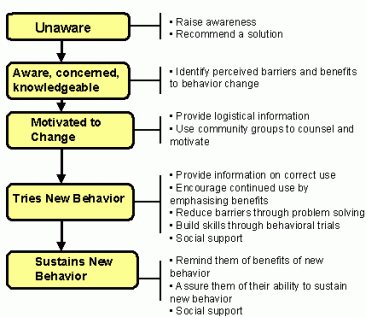part of my eating
plan.”
“I ruined my
Focusing on
“I wish I had not eaten
eating plan by
negative
so much pasta. But it
having so much
is only one meal. I
1276
pasta tonight.”
stuck to my eating
plan really well the
rest of the week.”
“I have had some
problems sticking
with an exercise plan
“I can never stick
in the past, but that
with an exercise
Overgeneralizing
does not mean I can
plan.”
not do it in the future.
I have made other
changes in my life.”
“I am going to try to
set a realistic goal.
Maybe it is a smaller
goal than before, but I
still am working
toward a healthy
“If I can not lose 8
weight. After all, even
pounds (lb) this
losing ½-1 lb/week is
month, then I am
All or nothing
moving in the right
going to give up
direction, and I still
this eating plan.”
have to create a 250-
to 500-calorie deficit
every single day; so, I
am doing something
right, even if I just lose
a small amount.”
Remind your clients that what they think can affect their actions, mood,
and feelings. Thought-stopping will help change how they think, so that
they feel better. Changing thinking will take some time. They will need to
practice thought-stopping every day. After a while, they will have the
ability to stop those unwanted thoughts right away. Stress that they can
do it!
1277

References
Flagg M. Positive thinking: stopping unwanted thoughts. Available at:
http://www.pamf.org/health/healthinfo/?A=C&type=info&hwid=uf9938
§ion=uf9939. Accessed October 3, 2009.
Miller WR, Rollnick S. Motivational Interviewing: Preparing People for
Change. New York, NY: The Guilford Press; 2002.
Contributed by Shawna Gornick-Ilagan, MS, RD, CWPC
1278

4.27 STAGES OF THE CHANGE CONTINUUM
Facilitating Behavior Change
Motivation is a key factor in successful behavior change This chapter
presents techniques that will be useful in assessing motivation and
helping others increase their intrinsic motivation to change their
behavior.
READINESS TO CHANGE
Behavior change is rarely a discrete, single event. During the past
decade, behavior change has come to be understood as a process of
identifiable stages through which people pass (Zimmerman et al., 2000).
The Stages of Change model describes five stages of readiness:
precontemplation, contemplation, prepar-ation, action, and maintenance
- and provides a framework for understanding behavior change
(DiClemente and Prochaska, 1998).
For most people behavior change occurs gradually over time, with the
person progressing from being uninterested, unaware, or unwilling to
make a change (precontemplation), to considering a change
(contemplation), to deciding and preparing to make a change
(preparation). This is followed by definitive action, and attempts to
maintain the new behavior over time (maintenance). People can
progress in both directions in the stages of change. Most people will
1279
"recycle" through the stages of change several times before the change
becomes fully established (Zimmerman et al., 2000).
The Stages of Change model is useful for identifying appropriate
interventions to foster positive behavior change (Table 6); by identifying
where a person is in the change process, interventions can be tailored to
the person's "readiness" to change (Zimmerman et al., 2000). Anything
that moves a person along the continuum towards making a positive
change should be viewed as a success. Once the person reaches the
contemplation stage, additional strategies can be employed to help the
person move along the stages of change.
It is important to evaluate a person's readiness to change for any
proposed intervention (Zimmerman et al., 2000). Interventions that are
not staged to the readiness of the individual will be less likely to succeed.
Also, interventions that try to move a person too quickly through the
stages of change are more likely to create resistance that will impede
behavior change.
For example, if trying to get a person to quit smoking, it is essential to
know where the person is in his or her readiness to stop. A person who
is not even thinking about quitting smoking (precontemplation) is
generally not ready to receive information about specific smoking
cessation aids. In this case, focusing the intervention on smoking
cessation aids sends the message that the health care provider is not
really listening. This may not only damage rapport but can also make the
person even more resistant to quitting smoking. A more stage-specific
intervention with this person would be to try to get the person to think
about quitting (contemplation). Once the person reaches the
contemplation stages, additional strategies can be employed to continue
to move the person through the stages of behavioral change.
Anything that moves a person along the continuum toward making a
positive change should be viewed as a success. Employing stage-specific
interventions will decrease provider frustration by lessening the
unrealistic expectation that change will occur with a single intervention.
CHARACTERISTICS AND STRATEGIES OF THE STAGES
STAGE
CHARACTERISTICS
STRATEGIES
1280
The person is not even considering
changing. They may be "in denial" about Educate on risks
Precontemplation their health problem, or not consider it versus benefits and
(unaware)
serious. They may have tried
positive outcomes
unsuccessfully to change so many times related to change
that they have given up.
Identify barriers and
Contemplation
The person is ambivalent about changing. misconceptions
(Aware,
During this stage, the person weighs
Address concerns
concerned,
benefits versus costs or barriers (e.g.,
Identify support
knowledgeable)
time, expense, bother, fear).
systems
Develop realistic
Preparation
goals and timeline
The person is prepared to experiment
for change
(Motivated to
with small changes.
change)
Provide positive
reinforcement
Action
The person takes definitive action to
Provide positive
(Trying new
change behavior.
reinforcement
behaviour)
Maintenance and
Relapse
Provide
Prevention
The person strives to maintain the new encouragement and
behavior over the long term.
(Sustaining new
support
behaviour)
Source: Zimmerman et al., 2000; Tabor and Lopez, 2004
A question that can be put to individuals to help evaluate their readiness
to change can be as simple as: "Are you willing to take a medication to
treat your condition?" Readiness to change can also be evaluated using a
more quantitative scale: "How ready are you on a scale from 1 to 10 to
initiate this therapy (medication, diet, exercises) to treat your
condition?"
1281
Two major factors that have been found to affect a person's readiness to
change are "importance" and "self efficacy". Importance is determined by
what value a person places on making the change. Self efficacy is a
person's belief or confidence in their ability to succeed at making the
change. Depending on the health scenario, people may exhibit different
levels of importance and self efficacy (Rollnick et al., 1999).
A person who is overweight may be convinced of the importance of
losing weight but have a low level of confidence based on previous
failure to lose weight or keep weight off. A person who is newly
diagnosed with hypertension may be confident that they can take a pill
to lower blood pressure but are not convinced of the importance of this
action. A deficiency in either importance or self efficacy can lead to a
person's unwillingness to commit to change.
The Readiness-to-Change Ruler is used to assess a person's willingness
or readiness to change, determine where they are on the continuum
between "not prepared to change" and "already changing", and promote
identification and discussion of perceived barriers to change.
The Readiness-to-Change Ruler can be used as a quick assessment of a
person's present motivational state relative to changing a specific
behavior, and can serve as the basis for motivation-based interventions
to elicit behavior change, such as motivational interviewing.
Source: Copyright � 2006 American Society on Aging and American
Society of Consultant Pharmacists Foundation; all rights reserved.
1282

Audiences along a Behavior Change Continuum: Possible
Communication Strategies
1283
4.28 CONGRUENCE
Be authentic (genuine), open and honest to a coachee. Help him in a
pleasant and straightforward way to address his problems. You are no
good to a coachee if you don't help him discover what the real problem is
and how he might solve it. Discovering the truth can be painful to the
coachee, but the way you assist him can make all the difference. Adjust
your approach to the type of coachee. Avoid creating a sense of being
exposed or having to get all defensive because you are too direct or too
assertive. The goal is to help the coachee, not to be assertive. Act like a
friend.
Nobody listens to me. I feel like I don't exist. At home, at the office,
whatever I say, it doesn't register. They think they know it all. Why don't
they listen? I have forty years of experience.
You're telling me people don't listen to you. During our discussions
you have taken the initiative and a tight control. It's been hard for
me to break into the conversation or to turn it into a dialogue. I can
imagine that some people dislike that and therefore ignore you. Do
you think it might be possible that this creates the impression
people aren't listening to you?
Well, uh... I don't know.
I have noticed you cross your arms a lot and that you are often
looking at the floor.
Mister Johnson....
No, just listen to me for once. Maybe it's me, but every time I try to
say something you interrupt me. How is that in other situations, for
instance when someone wants to explain something to you?
In the next example the coachee is an overaged hippie looking for work:
Okay, you didn't get the job. That can happen to the best of us. I know
this is not a job interview but when I look at you... the way you're
dressed, your unconventional hairdo, the odour around you - I wonder
what a potential employer thinks of it and if that's what he is looking for?
Has he gone crazy to say all that, the effing wanker!
1284

I can take a lot and frankly, you can say what you like in here, but
with that kind of language it is quite possible your teacher doesn't
think too highly of you.
A blond visits the doctor and asks...
What strikes me is that every time we get to the heart of the matter,
you start telling a joke. The jokes make me laugh, but what I would
really like to do is to help you find out what the problem really is and
to help you solve it.
Source:
The Art of Counselling / De Kunst van het Counselen
© Copyright Owner:
Academy for Counselling and Coaching - The
Netherlands - Paul van Schaik
1285
4.29 AUTHENTICITY
Every man builds his world in his own image. He has the power to
choose, but no power to escape the necessity of choice.
Ayn Rand, philosopher
The concept of authenticity has received a significant amount of
attention recently as people search for meaning and happiness,
particularly in their work lives. How one chooses to try to live more
authentically depends on their own perspective on authenticity. Like
many other popular concepts, different people have different views
about authenticity and many people feel very strongly about their own
views. Some people might assert that an individual is being authentic if
they are being completely honest and participating in the here-and-now,
eg, an honest conversation with a friend, completely focused on cleaning
out the garage, etc. There are others who assert that authenticity
involves many other features, including, eg, always being centered with
themselves and others, living in a completely integrated fashion with
their own values and principles, always feeling complete meaning or
sense of purpose in their lives, etc.
The concepts of "authenticity" and "meaning" can seem almost the same.
However, the major philosophical movement called existentialism has
studied authenticity for centuries and helps us understand more abut
what authenticity is, along with its relationship to the concept of
meaning. Existentialists assert that if an individual is not living
authentically in their lives, then they lose meaning and can fall into
chronic anxiety, boredom and despair. People might pursue "quick fixes"
to avoid the responsibility of living authentically, eg, quick fixes such as
anesthetizing themselves with alcohol or drugs, living in fantasies, etc.
Others might even assert that it's inauthentic to pursue any approach
(programs, books, etc.) that promises to help people transcend (escape?)
the responsibilities -- and sometimes drudgery -- of day-to-day living.
Regardless of others' perspectives on authenticity, it's important for
people in management to live and work as authentically as possible -- a
goal that is usually often difficult to achieve, particularly in large
1286
organizations. As mentioned above, how one chooses to live a more
authentic life depends on their perspective. A person might choose to
appreciate more their own current approach to life, or meditate on a
regular basis, or journal (write down) their thoughts, or engage in
regular retreats, or sign up for a more complete program, etc.
Major Benefits of Authenticity
Peter Block, in his book Flawless Consulting, asserts that authenticity is
one of the critical aspects of successful consulting (along with
successfully carrying out the phases of consulting). There are several
reasons for the importance of authenticity.
1. Encourages coachees to be open, honest and direct in the here-and-
now.
The collaborative consultant wants the coachee to be as open and honest
as possible. The consultant can encourage open and honest behavior in
others by modeling that behavior themselves. This helps the consultant
to fully understand the coachee and provide useful feedback that the
coachee will hear, as well.
Authenticity from your coachee also provides extremely valuable
feedback to you. Frequently, you do not have sufficient opportunity to
continually learn about yourself, particularly in settings with your
coachees. Coachees who choose to be authentic around you are offering
you a precious gift that can be used by you to cultivate a collaborative
consulting relationship with them and others.
2. Builds coachee’s trust and confidence in your relationship.
You can build a strong relationship with your coachee by showing them
that you trust them enough to be able to handle the truth. In turn, they
will do the same thing for you. Trust and confidence are critical
ingredients for a successful working relationship between you and your
coachee.
3. Deals with issues before the issues fester.
When people express themselves honestly in the here-and-now, they are
much more likely to report issues as soon as they notice them. This
1287

ensures that issues are addressed when they occur, rather than festering
until they show themselves as major forms of resistance to change
during the project.
4. Considers important “data” about the coachee’s situation.
Information that you gather from your other senses is important data
about your coachee’s situation. The more open and honest that you can
be about your own perceptions, the more likely that the data from your
senses will be accurate. Many times that data can be used to more
accurately understand your coachee’s situation.
5. Ensures organizational change efforts remain relevant, realistic and
flexible.
Plans rarely are implemented as planned. Authentic behavior from your
coachees helps all parties involved to accurately perceive and talk about
any changes in the project so, as a result, plans can be updated with
those changes and thereby remain up-to-date. Perhaps Terry, in his
book, Authentic Leadership, puts it best: “authenticity self-corrects.”
1288
Key Guidelines to Authentic Behavior
Block and various schools of psychology, for example, Carl Rogers’ self-
directed therapy, describe the following core characteristics of authentic
behavior. Considering their descriptions, authentic behavior is more
attainable than many believe and it might help you to work easier rather
than work harder in your projects for change.
1. Honest -- Speak the truth.
2. Direct -- Speak in terms that are clear, concise and focused.
3. About here-and-now -- Speak about what is going on right now.
4. From you -- Report your own experience of the here-and-now.
5. Non-judgmental of others -- Speak about what you are experiencing
around others, not of your judgments of others.
Unless you are authentic in a supportive manner, coachees might feel
like you are being aggressive. Aggressive behavior is perceived as
demanding, forceful, arrogant and even hostile. That can cause
discomfort, alienation, confusion and distrust between you and your
coachees. Experienced consultants have learned to employ authentic
communication in a manner that is completely honest, yet remains
supportive and respectful.
Note that authentic behavior does not always mean the consultant’s
speaking the truth about anything and everything all the time.
Sometimes the consultant senses that the coachee is not yet ready to
hear about the consultant’s speculations, for example, about causes of
issues or the coachee’s role in those issues. Sometimes these
speculations would simply overwhelm and confuse the coachee.
In every case, it is up to the consultant’s judgment as to how much they
“think out loud.” However, usually there is more of a downside to not
being authentic than the downside of sharing your thoughts and
impressions with your coachees.
1289
4.30 PARADIGMS
Businessdictionary.com defines paradigm as: Intellectual perception or
view, accepted by an individual or a society as a clear example, model, or
pattern of how things work in the world.
Their definition of paradigm shift is: A fundamental change in an
individual's or a society's view of how things work in the world. For
example, the shift from earth to sun as the center of solar system,
'humors' to microbes as causes of disease, heart to brain as the seat
of thinking and feeling.
Read more:
http://www.businessdictionary.com/definition/paradigm.html#ixzz1kh
aEStEu
Webster Dictionary describes a paradigm as "an example or pattern:
small, self-contained, simplified examples that we use to illustrate
procedures, processes, and theoretical points."
The most quoted definition of paradigm is Thomas Kuhn's (1962, 1970),
i.e. paradigm as the underlying assumptions and intellectual structure
upon which research and development in a field of inquiry is based. The
other definitions in the research literature include:
1. Patton (1990): A paradigm is a world view, a general
perspective, a way of breaking down the complexity of the real
world.
2. Paradigm is an interpretative framework, which is guided by "a
set of beliefs and feelings about the world and how it should be
understood and studied." (Guba, 1990). Denzin and Lincoln
(2001) listed three categories of those beliefs:
Ontology: what kind of being is the human being. Ontology
deals with the question of what is real.
Epistemology: what is the relationship between the inquirer
and the known: "epistemology is the branch of philosophy
that studies the nature of knowledge and the process by
1290
which knowledge is acquired and validated" (Gall, Borg, &
Gall, 1996)
Methodology: how do we know the world, or gain
knowledge of it?
When challenging the assumptions underlying positivism, Lincoln and
Guba (2000) also identified two more categories that will distinguish
different paradigms, i.e. beliefs in causality and oxiology.
The assumptions of causality asserts the position of the nature and
possibility of causal relationship; oxiology deals with the issues about
value. Specific assumptions about research include the role of value in
research, how to avoid value from influencing research, and how best to
use research products (Baptiste, 2000).
Dill and Romiszowski (1997) stated the functions of paradigms as
follows:
Define how the world works, how knowledge is extracted from
this world, and how one is to think, write, and talk about this
knowledge








